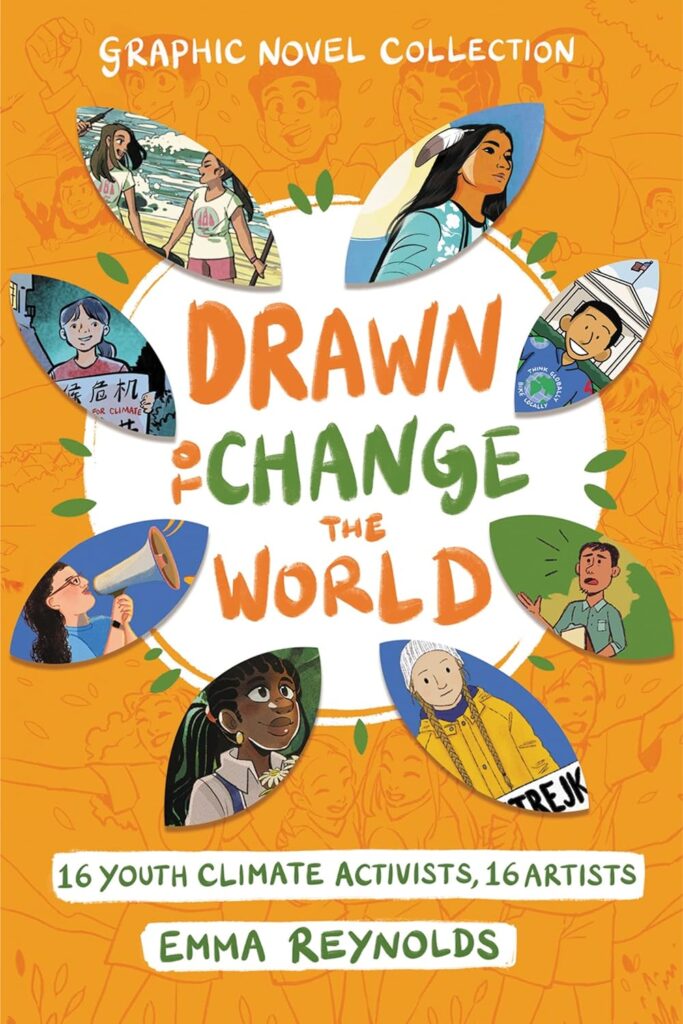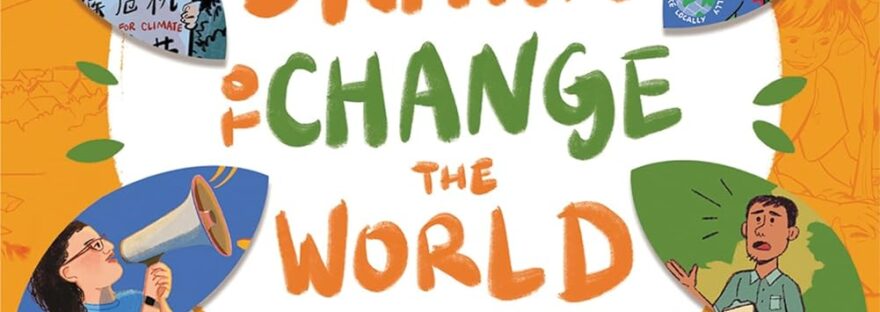By author Emma Reynolds and various illustrators listed at the end of the review (published by HarperAlley, September 2023)
This book is not about putting the sole responsibility on young people’s shoulders to fix this crisis. It’s about celebrating the activists who are doing incredible things, and encouraging whoever is reading this book that you can make a difference too, no matter your age. You are not too old, and you are not too young, to begin.

Here at Libraries 4 Schools, we believe graphic novels are a great way of sharing non-fiction information and stories, and Drawn to Change the World: 16 Youth Climate Activists, 16 Artists is no exception – except in what it’s trying to achieve.
The book covers the first campaigning efforts by 16 youth activists around the world; what problems they saw, and how they took their first steps in being part of the solution. And a bit like them, that’s how this book came into being.
Reynolds explains in the “about this book” at the front that it all started when she looked around at climate issues, and realised that she needed to do something. She had an epiphany on what she could do within her field and, unlike many of the rest of us in those moments, actually followed it through.
So she began the #KidLit4Climate campaign online, the first global illustrated climate campaign, which drew thousands of submissions from every continent. Eventually it would lead here, to this book.
After the “about”, there is an introduction from science communicator and environmentalist Matthew Shribman, co-founder of AimHi Earth which offers masterclasses in climate and sustainability to big companies, politicians, and individuals alike. To have his stamp of approval on the book is an endorsement indeed!
After that, there is an illustrated section laying out the basic facts about climate change and how its caused, some fascinating figures to back the science up, and a quick look at which communities are the most vulnerable. It’s an easy and engaging way to give the reader a foundation to work from.
After that, we get into the main focus of the book, the illustrated stories about the young activists. Each one is drawn by a different illustrator, which helps keep the reader’s attention, as well as the short lengths – most entries are only 4 pages, with one running to 6. Since the stories take place at different times, I appreciated the short summary at the end of each section detailing where the activist is now.
Some of the names or places will be familiar to you; Greta Thunberg is in there of course, as well as the Dakota Access Pipeline (DAPL) that was all over the worldwide news, at least for a little while – though I bet most of us hadn’t heard of Tokata who was only 12 when she stepped up to protest it.
The stories and issues covered in Drawn to Change the World are both inspiring and heartbreaking, but all are portrayed in an accessible manner. Many – though not all – of the activists are from minority groups, and although the diversity is good to see, it is in part the result of the issues hitting these groups harder than others.
So many of the issues are ongoing as they are too large or worse, simply remain unresolved, often due to pushback from politicians or companies. This could easily cause readers to feel that the situations are hopeless, but each story shows the importance of standing up for the planet, even when it’s difficult.
It is disheartening to see the stories from those in authoritarian states such as China and Russia. To see how these young people have been criminalised for trying to hold a simple demonstration is frustrating and troubling, and it makes you look closer at the actions of your own country (I’m writing this from the UK, where the Public Order Bill passed earlier this year was widely denounced by many, including the UN High Commissioner for Human Rights).
It’s not all doom and gloom however. The book highlights several smaller-scale campaigns that are progressing well, or that are resolved, such as the Wijsen sisters who got single-use plastics planned on their home island of Bali. Even the larger, ongoing campaigns are tinged with hope, brought to life here through the fantastic art and the bravery of the youngsters involved.
The back of the book features a short piece written by one of the activists and an interview between two of them and Reynolds, as well as a glossary, a timeline of significant climate events, and a section explaining some of the more complex agreements and groups. Everything is put forward in a clear and understandable way, perfect for those coming to this information for the first time.
Also at the back is a small section about things that you can do as an individual – it is true that most of the carbon emissions come from a small percentage of large companies but, as we’ve seen in the book, even one person can make a difference, no matter how things seem. There is a list of resources, from websites to podcasts to books, that would be great to look through and study with young readers.
The book is written with ages 8-12 in mind, but I found it excellent and useful reading even as an adult. The way the book is laid out makes it easy to follow, and the illustrations help make it accessible for those who are new to the topic. The age of the activists makes them relatable for the intended reader age, and hopefully can serve to inspire them to take action of their own.
This is a book that we would definitely recommend not just for those already interested in the climate or activism but as an opportunity to learn more, especially for schools looking to teach on the subject.
The following is a list of the activists featured, alongside their country and the illustrators who depicted them, should you want to learn more about them and their projects:
Autumn Peltier (Canada) – by Natasha Donovan
Tokata Iron Eyes (USA) – by Gloria Félix
Melati and Isabel Wijsen (Indonesia) – by Ann Maulina
Edgar Edmund Tarimo (Tanzania) – by Bill Masuku
Jamie Margolin (USA) – by Teo DuVall
Jerome Foster II (USA) – by Derick Brooks
Greta Thunberg (Sweden) – by Emma Reynolds
Ridhima Pandey (India) – by Shivana Sookdeo
Daphne Frias (USA) – by Devon Holzwarth
Iqbal Badruddin Jamal (Pakistan) – by Anoosha Syed
Jean Hinchliffe (Australia) – by Erin Hunting
Arshak Makichyan (Russia) – by Margarita Kukhtina
Ōu Hóngyì (China) – by Jade Zhang
Leah Namugerwa (Uganda) – by Natasha Nayo
Dara McAnulty (Ireland) – by Victoria Maderna & Federico Piatti
If you’d like to see how these activists got started and what you can do to help, you can grab a copy at the link below.
(Disclosure: If you buy books linked to our site, we may earn a commission from Bookshop.org, whose fees support independent bookshops.)
Looking for more books about current issues? If so, you can see our previous reviews here.

